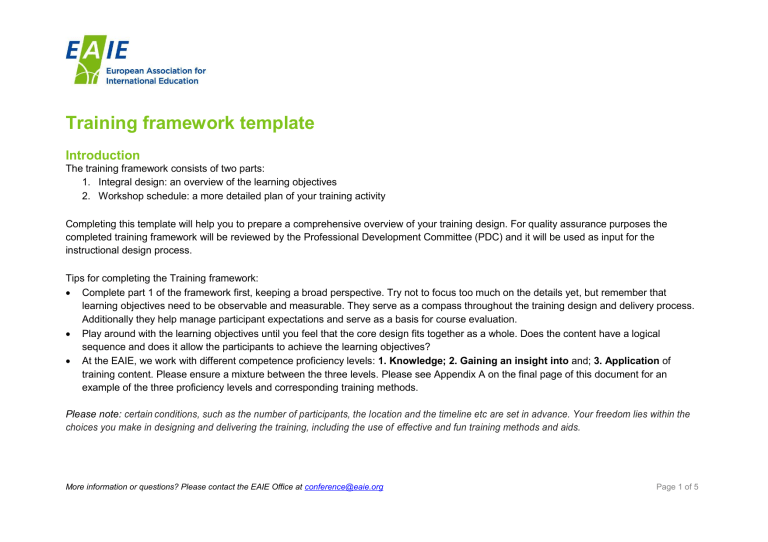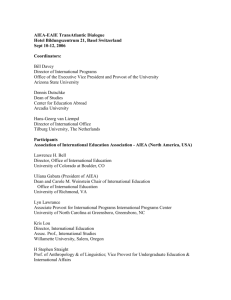
Training framework template Introduction The training framework consists of two parts: 1. Integral design: an overview of the learning objectives 2. Workshop schedule: a more detailed plan of your training activity Completing this template will help you to prepare a comprehensive overview of your training design. For quality assurance purposes the completed training framework will be reviewed by the Professional Development Committee (PDC) and it will be used as input for the instructional design process. Tips for completing the Training framework: Complete part 1 of the framework first, keeping a broad perspective. Try not to focus too much on the details yet, but remember that learning objectives need to be observable and measurable. They serve as a compass throughout the training design and delivery process. Additionally they help manage participant expectations and serve as a basis for course evaluation. Play around with the learning objectives until you feel that the core design fits together as a whole. Does the content have a logical sequence and does it allow the participants to achieve the learning objectives? At the EAIE, we work with different competence proficiency levels: 1. Knowledge; 2. Gaining an insight into and; 3. Application of training content. Please ensure a mixture between the three levels. Please see Appendix A on the final page of this document for an example of the three proficiency levels and corresponding training methods. Please note: certain conditions, such as the number of participants, the location and the timeline etc are set in advance. Your freedom lies within the choices you make in designing and delivering the training, including the use of effective and fun training methods and aids. More information or questions? Please contact the EAIE Office at conference@eaie.org Page 1 of 5 Part 1 – Integral design In order to create the first overview of your training activity design, list all the overall learning objectives you mentioned in your workshop proposal and then add the corresponding training and delivery methods. Workshop learning objectives Learning objective 1 Training method Learning objective 2 Training method Learning objective 3 Training method [add rows if needed] [add rows if needed] More information or questions? Please contact the EAIE Office at conference@eaie.org Page 2 of 5 Part 2 - Workshop schedule Delivering a workshop involves multitasking. You present, keep an overview of the programme, keep time, listen, stimulate interaction, keep an eye on the energy level of your participants and much more. Next to this, you need to make sure that both you and your co-speaker(s) have a clear plan to follow. Being well prepared as a team will help you deliver a great workshop. Looking at your learning objectives from part 1, decide what roles and tasks each trainer will take on. Think of your target audience and take time to brainstorm together what the most suitable training methods to achieve the learning outcomes are. Will you be using group work, quizzes or case studies etc? Decide how you want to work together and add this under co-speaker agreements in the more detailed workshop schedule below. Please note: the timeslots for coffee and lunch breaks as well as start and end times as indicated below are fixed and cannot be altered. You can add, however, sub-timeslots within the various training slots. Time Subject Learning objectives Training methods Co-speaker agreements 09:00–10:30 Morning (if applicable) 10:30–11:00 Break 11:00–12:30 12:30–13:30 Lunch 13:30–15:00 Afternoon (if applicable) 15:00–15:30 Break 15:30–17:00 More information or questions? Please contact the EAIE Office at conference@eaie.org Page 3 of 5 A final check and submission of your training framework Ask yourself: How does this overview bring you to your main learning objective? Is it aligned with your ambition? Enough ambition? Too much? Have you thought about your audience and their learning preferences? Does the programme schedule make sense? Is there a good flow in the programme? Scan your training methods and ask yourself – have I incorporated the different proficiency levels? (see Appendix A) Have I added in enough ‘action learning’ and a variety in training methods? Appendix A: Competence proficiency levels example For a management training, a module teaches managers how to handle yearly performance management conversations with their employees. For this module, the following learning objectives have been identified: Knowledge After this module, managers will have gained an understanding of the different methods in which a performance management conversation can be prepared, conducted and completed. After this module, managers will have an increased awareness of the employee’s perspective. Corresponding training method: In order to understand a concept, content needs to be explained. This is the instruction or presentation part of the course. Gain an insight into After this module, managers will gain an insight into the different aspects that are part of a performance management conversation. More information or questions? Please contact the EAIE Office at conference@eaie.org Page 4 of 5 After this module, managers will gain an insight into how performance management conversations contribute to increased team effectiveness and business results. Corresponding training method: Gaining an insight into a concept happens if participants can ‘play’ with the concept and integrate it into their own frame of reference. By reviewing it, discussing it and thinking about it, they become aware of the bigger context and what happens when the concept is applied in real life. This can be done, for example, through group discussions, brainstorming sessions or individual reflection. Being able to apply a concept After this module, managers will be able to apply effective conversational techniques during performance management conversations. After this module, managers will be able to handle challenging situations during performance management conversations, applying best practices and techniques learned during the course. Corresponding training method: Applying a concept happens when participants practice the concept in the classroom. This can be done by having participants work on case studies or practice role-plays in breakout groups. More information or questions? Please contact the EAIE Office at conference@eaie.org Page 5 of 5


